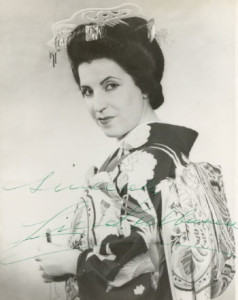Die langjährige Sopransäule der Metropolitan Opera New York, Licia Albanese (eigentlich Felicia Albanese), starb am 15. August 2014 in New York/Manhattan im Alter von 105 Jahren. Sie wurde am 22. Juli 1909 in Bari geboren und bei Giuseppina Baldassare-Tedeschgi ausgebildet. Sie verließ 1939 Italien nach ihrem Bühnendebüt als Madama Butterfly am Teatro Lirico Mailand und Auftritten in regionalen Theatern, nahm 1940 die US-amerikanische Staatsbürgerschaft an, heiratete 1945 Jahr den Finanzmann und Vorsitzenden der amerikanischen staatlichen Rennorganisation Joseph Grimma und wurde zu einem Synonym des damaligen Met-Standards, als sie im alten wie im neuen Haus mehr als 400 Aufführungen vor allem das lyrische Fach mit Ausflügen ins schwerere wie Madama Butterfly (mehr als 300 mal), Mimì oder Tosca sang. Aber auch die San Francisco Opera profitierte von Ihrer Anwesenheit – sie sang dort von 1941 – 1961 in mehr als 120 Aufführungen.

Licia Albanese als Manon an der Met//Bridge Puglia USA
Es war ihre permanente Verfügbarkeit, die ihr einen Namen der Zuverlässigkeit und des hohen Standards sicherte und die sie immer wieder auch kurzfristig einspringen ließen, so für die Bayreuther Aufnahme des Lohengrin bei Reldec/Decca. Obwohl sie auch an Häusern wie Covent Garden und großen Bühnen Amerikas sang, war sie doch eine Met-Sängerin, und ihre Aufführungen der Violetta, Butterfly oder Mimì waren Legion – sie war beste „Met-Ware“ und stand für die damaligen Qualitäten des Hauses. Die Langlebigkeit ihrer gutsitzenden, hellen und höhenbetonten Sopranstimme war ebenfalls legendär: Noch 1985 gab sie die alternde Diva Heidi Schiller in Sondheims Musical Follies mit den New Yorker Philharmonikern. 1966 hatte sie sich von der Met zurückgezogen, trat aber dort regelmäßig noch in den Galas auf und sang mit bestsitzender Stimme den „Star spangled Banner“. Ihre offizielle musikalische Hinterlassenschaft ist nicht sehr umfangreich (La Bohème und eine Live-Manon von der Met/CBS/Naxos und einige LPs/CBS/Naxos), aber ihre inoffiziellen Livemitschnitte gibt es reichlich, an ihr kommt kein Sammler vorbei. Im Folgenden eine biographische Wertschätzung der Sängerin von David Patmore in Naxos´ unersetzlicher Reihe von Künstlerbiographien. G. H.
In 1940 Albanese made her début at the Metropolitan Opera, New York, as Butterfly and achieved immediate success: she was to reprise this rôle on seventy-two occasions at the Metropolitan. She stayed with the company for twenty-six years, until in 1966, insulted by what she considered a derisory contractual offer by manager Rudolf Bing, she returned the document unsigned. At the Metropolitan Albanese sang a total of 427 performances of seventeen rôles in sixteen operas, establishing herself as one of her generation’s pre-eminent interpreters of Violetta/La traviata, and excelling as Manon/Manon Lescaut in addition to Butterfly. Other parts which she sang with the company included Nedda/Pagliacci, Marguerite/Faust, Susanna/Le nozze di Figaro, Donna Anna/Don Giovanni, Giorgetta/Il Tabarro, Tosca, Micaela, and Lauretta. She also sang regularly with the San Francisco Opera, whose music director Gaetano Merola she greatly admired, giving 120 performances of twenty-two rôles between 1941 and 1951.
The high esteem in which Albanese was held in America may be judged by the fact that it was she whom Toscanini invited to sing Mimì in the fiftieth anniversary broadcast of La Bohème, the first performance of which he had conducted in Turin in 1896. So successful was this that the maestro asked Albanese to sing Violetta in his subsequent broadcast of La traviata, also in 1946. Both these productions were afterwards released commercially on disc. Albanese made her Chicago début in 1941 as Micaela and went on to sing as a distinguished guest in Baltimore, Cincinatti, Philadelphia, San Antonio and St Louis. In 1951 she returned to La Scala, as Butterfly, which she also sang in the same year at Rio de Janeiro. She retired from the stage in 1970, but remained a force in opera in America through her teaching and the Albanese Puccini Foundation, which annually awards substantial cash grants to young opera singers.

Licia Albanese wird 1995 von Präsident Clinton die Medal of Artistic Award der USA überreicht/Bridge Puglia UA
Albanese’s voice in her early career had a most appealing freshness and innocence, as may be heard in her 1938 recording of La Bohème (Mimì) with Gigli, and in the excerpts from the 1937 Covent Garden production of Turandot (Liù) with Eva Turner, conducted by Barbirolli. Later her voice filled out, while retaining its range, flexibility and beauty of tone: her 1954 recording ofManon Lescaut, opposite Jussi Björling, is a fine example of her mature art. Other recordings of note are the studio recording of Carmen (Micaela) conducted by Fritz Reiner, and a live recording of La rondine (Magda) from 1960. Albanese possessed a strong dramatic instinct and sought to make her performances as fresh as possible, giving them considerable dramatic edge as well as musical warmth.
David Patmore (A–Z of Singers)/ Naxos Rights International Ltd..
Ein Live-Interview von 1988 mit Licia Albanese findet sich auf der website von Bruce Duffie: This interview was recorded on the telephone on February 26, 1988. A portion was published in The Massenet Newsletter in July, 1989, and other sections were used (along with recordings) on WNIB in 1998. It was fully transcribed, re-edited and posted on this website in 2012. To see a full list (with links) of interviews which have been transcribed and posted on this website, click here. Award – winning broadcaster Bruce Duffie was with WNIB, Classical 97 in Chicago from 1975 until its final moment as a classical station in February of 2001. His interviews have also appeared in various magazines and journals since 1980, and he now continues his broadcast series on WNUR-FM, as well as on Contemporary Classical Internet Radio. You are invited to visit his website for more information about his work, including selected transcripts of other interviews, plus a full list of his guests. You may also send him E-Mail with comments, questions and suggestions.




